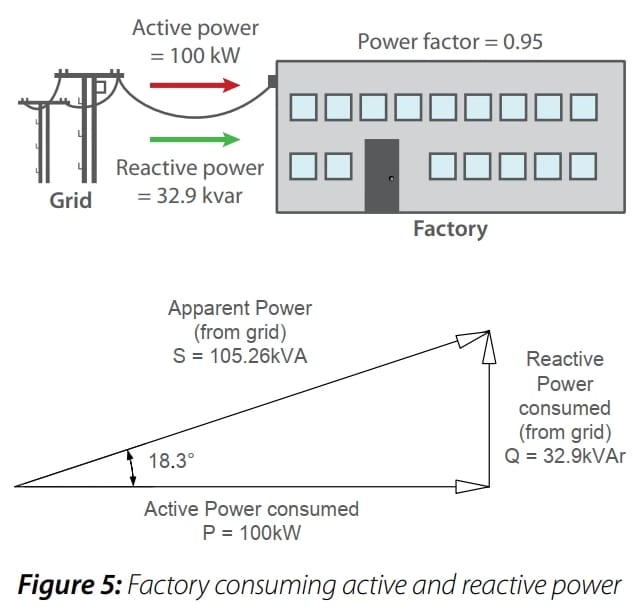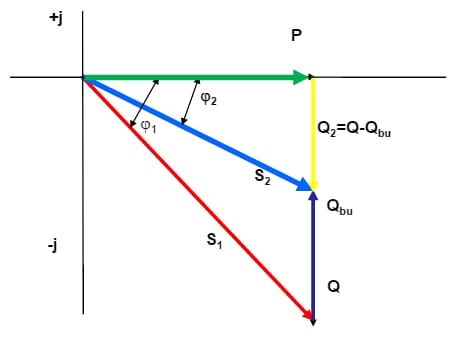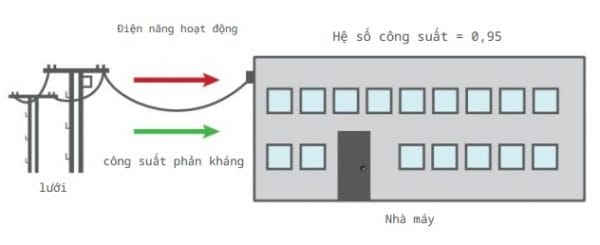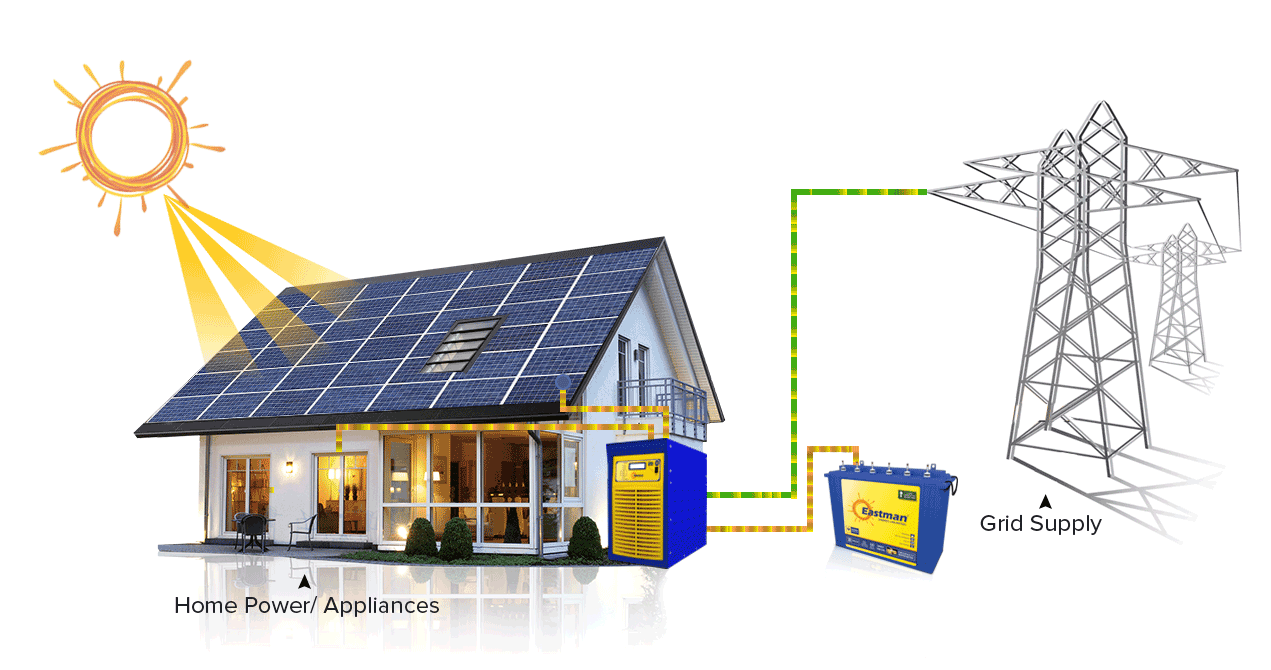Reactive power compensation for a solar PV system is the result of the difference between variable power and actual power. It occurs due to imbalance between the electrical characteristics of system components, such as solar panels, inverters and power cables. Reactive power creates power loss and reduces overall system performance.
What is reactive power compensation for solar power systems?
Reactive power compensation (Power Factor Correction - PFC) is a technology used in solar power systems to improve system performance and stability. When applying reactive power compensation, we try to ensure that the solar power system operates at a reactive power level close to 1, creating favorable conditions for power transmission and minimizing energy loss. .
To compensate for reactive power in a solar power system, a reactive power regulator (PFC) is often used. PFC is a type of electronic device integrated into the system to regulate reactive power and ensure that the system operates at a PF level close to 1. PFC is commonly used in solar power system applications with large capacity where high stability is required and the longevity of components is guaranteed.

Why is it necessary to compensate reactive power in solar power systems?
In solar power systems, reactive power compensation is necessary to ensure efficient operation, optimize performance and minimize energy loss. Below are some important reasons why reactive power compensation is needed in solar power systems:
- Optimize performance: When the solar power system operates at a reactive power close to 1 (i.e. has a high PF), the system performance is optimized. This helps reduce energy loss and increase the ability to transmit power from the solar power system to the grid.
- Reduce electrical system load: When reactive power is high, meaning PF is low, the solar power system will put a load on the electrical system. This can lead to overload, increased electricity costs, and damage to system components. By compensating reactive power, we reduce the load on the electrical system, reduce energy loss and extend the life of equipment in the system.
- Compliance with regulations and standards: Some countries and organizations have power quality regulations that include reactive power requirements. By compensating reactive power, we ensure that the solar power system complies with these standards and does not affect the general power system.
- Increased longevity and reliability: Applying reactive power compensation can help reduce stress and fatigue on key system components, such as inverters, transformers and current transformers. When the system operates at reactive power near 1, these components will be operated in better conditions, increasing their lifespan and reliability.

Influence of reactive power
Reactive power (Q) is the part of power that has no effect on generating work in an AC power system. It is generated by reactive components in the system and plays a role in the start-up process of inductive loads. However, increasing reactive power can cause negative problems as follows:
- Economic problem: Reactive power consumes a portion of electrical energy and users still have to pay for that amount of reactive power. This leads to economic waste.
- Technical problem: Reactive power causes voltage drop and energy loss during power transmission. This may affect system performance and stability.
- Penalties from the electricity industry: In some countries, the power factor cosφ is required to be 0.9 or higher. This is aimed at reducing voltage losses on transmission lines and increasing power transmission efficiency. If cosφ < 0.9, the user may be fined from the electricity industry for exceeding the allowed reactive power.
Because of the above problems, appropriate solutions are needed to compensate reactive power (Q), that is, improve power factor (cosφ). This helps reduce energy loss, reduce voltage drop and avoid fines from the power industry due to reactive power issues.

Why is it necessary to compensate reactive power for solar power systems?
Reactive power occurs due to the inductive nature of devices such as transformers and electric motors in the power system. In solar power systems, these devices also generate reactive power when converting voltage. The inverter system in solar power systems needs to use reactive power to maintain voltage stability when there are changes from external factors.
For this reason, to ensure system voltage stability and avoid having to buy reactive power when the power factor cosφ < 0.9, we need to compensate a fixed amount of reactive power for the system.
Often, we have to calculate the reactive power needed to compensate for the solar power system when the system's capacity is large. This often happens in industrial parks, factories or manufacturing plants when the system's capacity is much larger than the consumed capacity. This is the cause of the decrease in power factor cosφ.

Reactive power compensation problems in solar power systems
To compensate for reactive power in solar power systems, we often use capacitors or reactive power compensation devices. However, using capacitors or compensation devices does not always bring good results. Here are some common cases:
- A common case is when a reactive power compensation controller is installed immediately after the solar power system is connected, however, electricity consumption still increases and the business has to pay more for electricity bills. The reason is due to the method of connecting the energy access point above the reactive power compensation point. In particular, when the system capacity is greater than the business's load, the electricity provided by the solar power system can exceed 25% of the design load. This causes the system to still consume some reactive power even though there is a reactive power compensation controller.
- Another case is during the day when the solar panel generates enough electrical energy without using grid power, the reactive power compensation device will not work. However, at night, this device still works normally. In this case, if the reactive power demand of the load does not change, the power factor cosφ calculated by the reactive power compensation controller may have a negative value. This not only wastes energy but also affects electrical equipment (causing damage) due to overvoltage of the power grid.
Reactive power compensation solutions for solar power systems
To compensate reactive power for solar power systems, there are two common methods:
- Adjust the working mode of the reactive power compensation controller: Change the working mode of the controller to compensate according to reactive power instead of compensating according to the target cosφ power factor. However, this method is not accurate and can lead to undercompensation or overcompensation of reactive power, causing energy loss.
- Use active reactive power compensators (SVG): Replace capacitor banks with active reactive power compensators (SVG) in solar power systems. This device is capable of compensating only the correct level of reactive power needed for the load, avoiding overcompensation. SVG is highly dynamic, able to calculate and provide the right level of reactive power for necessary needs. Meanwhile, conventional capacitor banks cannot monitor the load and can lead to ineffective undercompensation or overcompensation. Furthermore, SVG still works well even when grid voltage is low, helping to overcome reactive power problems on current solar power systems.

How to choose and install a reactive power regulator (PFC) for a solar power system?
Selecting and installing a reactive power regulator (PFC) for a solar power system requires attention and knowledge of the operating principles of PFCs and the specific requirements of the system. Below is an overview process to help you make the decision and install PFC for your solar PV system:
- Assess requirements and goals: Determine the requirements and goals of your solar power system. This includes power, reactive power, efficiency and stability.
- Research and learn: Learn about the types of PFCs available on the market and understand how they work. Review the features, performance, reliability, and compatibility of each type of PFC.
- Data statistics: Collect information about the technical parameters of the current solar power system, including capacity, voltage, current, power factor, and reactive power. This will help determine the specific requirements for PFC.
- PFC selection: Based on the information collected, choose the type of PFC that suits the requirements of the solar power system. Consider factors such as rated power, rated reactive power, operating voltage, protection features, and compatibility with other components in the system.
- Check compatibility: Ensure that the selected PFC is compatible with other components in the system, including controllers, inverters, and other devices. Check both hardware and software compatibility.
- Installation and configuration: Install and configure PFC according to the manufacturer's instructions. Make sure that the settings are done correctly and according to the correct procedure.
- Check and Adjust: Conduct PFC checks and adjustments to ensure correct and efficient operation. This includes testing the system's reactive power, performance and other parameters.
- Monitoring and maintenance: Monitor PFC and solar power system performance over time. Perform routine maintenance and testing to ensure that the PFC operates stably and efficiently.
Epilogue
Reactive power compensation is an important part of optimizing the operation of a solar power system, ensuring efficient use of solar energy sources and maintaining system stability under different conditions.